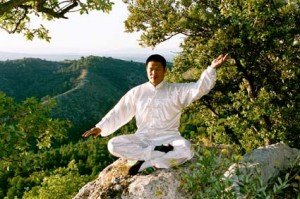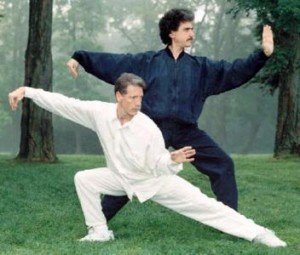Are you practicing Taichi Chuan or Taichi Cao?
by Violet Li
Recently, I took a random, unscientific survey by asking two dozen Taichi practitioners whether they sometimes feel sensations in their fingers when they practice Taichi. Some of  them have over five years of experience studying and practicing Taichi. To my surprise, less than 25% of the people stated that they feel their fingers warm, “swollen”, “numb”, or having an electric type of sensation. One jokingly said that one of his fingers was injured a long time ago before he started practicing Taichi and that finger feels numb when he practices Taichi.
them have over five years of experience studying and practicing Taichi. To my surprise, less than 25% of the people stated that they feel their fingers warm, “swollen”, “numb”, or having an electric type of sensation. One jokingly said that one of his fingers was injured a long time ago before he started practicing Taichi and that finger feels numb when he practices Taichi.
According to Dr. Kevin Chen, Taichi is a form of Chi Gong Qigong. One of the most important benefits of practicing Taichi is to cultivate Chi (Qi), the vital internal energy. Chi is essential to health. If the Chi is sufficient, balanced and circulating properly, it helps to prevent diseases and heals ailments and injuries. Study after study shows that Chi Gong or Taichi can provide substantial health benefits.
Chi is somewhat abstract or foreign to most people. Many Taichi practitioners, especially beginners, often wonder how to cultivate Chi, how to move Chi, and how to feel Chi. Proper body alignment, correct move-ments, breathing slowly, softly and correctly, and mindfulness are keys to Chi cultivation and circulation. It may take years of practice to be effective. Grandmaster Chen Zhenglei, a 19th generation Chen Style Taichi lineage holder and one of the Top Ten Martial Arts Masters in China, offers a simple yet quintessential piece of advice to these questions- relaxing. In his book Chen Style Taijiquan, Sword and Broadsword, Grandmaster highlights the most important requirement of practicing Taichi is to relax. First, relaxing the mind and letting go of any thoughts; then relaxing the body. According to Grandmaster Chen, when the body is tense, Chi does not flow freely. The common problems of a protruded head, tension in the neck, elevated and/or uneven the shoulders, raised elbows, tensed fingers/hand, and unnecessary toes lifted, are symptoms of a body which is not at ease. Clenching the fist too tight can also block Chi movement and make the punch less powerful. In his book, he provides detailed information for proper body alignment.
Grandmaster Chen points out that relaxing the shoulders and sinking the elbows is our body’s natural posture and we should maintain these placements when practicing Taichi. However, some practitio ners, especially beginners, tend to tense up, e.g. raising shoulders during the chi shi (beginning movement) as the arms move upwards to shoulder level.
ners, especially beginners, tend to tense up, e.g. raising shoulders during the chi shi (beginning movement) as the arms move upwards to shoulder level.
Grandmaster Chen emphasizes that Taichi movements are designed according to the human body’s kinetics. To keep the body in harmony during Taichi practice is essential. Grandmaster Chen sugeests that we keep our shoulders down and elbows sunk while doing simple daily tasks, i.e. answering a call, typing on a keyboard, or shaking hands with a friend. We do not feel comfortable if we shrug our shoulders or extend or stiffen our elbows outwards while doing these daily tasks. Then why change the principle when practicing Taichi? This may sound rhetorical. However, during practice, many people are not aware that their body tenses up as a result.
Pounding the Mortar (Jin Gang Dao Dui) is one of the most applied movements. In Chen style Old Frame Routine One (Lao Jia Yi Lu), there are four instances of Pounding the Mortar. It is important to drop elbows during transition movements. Grandmaster reminds students to pay close attention to their shoulders when lifting the right leg and right arm while doing this movement. Another important requirement is keeping the space under the armpits rounded so the Chi can flow easily from the body through the shoulders down to the arms. He urges Taichi enthusiasts constantly to check their body dispositions carefully and monitor them to see if their bodies unintentionally tensed up during the Taichi movements. Once the body is relaxed, a practitioner will feel the fingers are warm, slightly “swollen”, “numb” and electrified because the circulations of Chi and blood speed up and reach the extremities of the body. It is quite the sensation Without reaching any of these feelings, Grandmaster Chen Zhenglei believes that a practitioner is only doing Taichi Cao (exercise) not Taichi Chuan (Ch’uan). Taichi Cao is just a workout regimen which provides the same health benefits as other types of exercises; on the other hand, Taichi Chuan can deliver exceptional health betterment above and beyond regular workouts.
——————————————————– [Violet Li is a Taichi (Taiji) enthusiast and certified instructor. She has taught Taichi to different demographic groups and estab-lishments in St. Louis (AT&T, Mathews-Dickeys Boys and Girls Club, West County YMCA – St. Louis, private studio, senior centers and others). Violet is also well-versed in other fitness regiments. She taught Aerobics and Kickboxing before. She is a cer-tified HeartZone Personal Trainer and a Aerobics & Fitness Association of America (AFAA). You can read more about her writ-ings at http://www.examiner.com/x-16087-St-Louis-Tai-Chi-Examiner. You can reach her by email at Violet.Li@tadi.com ]
[Violet Li is a Taichi (Taiji) enthusiast and certified instructor. She has taught Taichi to different demographic groups and estab-lishments in St. Louis (AT&T, Mathews-Dickeys Boys and Girls Club, West County YMCA – St. Louis, private studio, senior centers and others). Violet is also well-versed in other fitness regiments. She taught Aerobics and Kickboxing before. She is a cer-tified HeartZone Personal Trainer and a Aerobics & Fitness Association of America (AFAA). You can read more about her writ-ings at http://www.examiner.com/x-16087-St-Louis-Tai-Chi-Examiner. You can reach her by email at Violet.Li@tadi.com ]

4 Responses to The Tai Chi Examiner